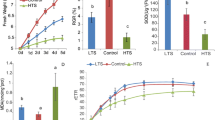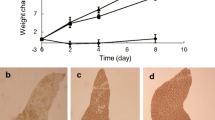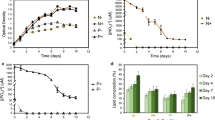Abstract
Based on the growing concern for global warming, changes in the lipid profile of the red alga Pyropia haitanensis were examined under different high temperatures. Lipidomes of P. haitanensis cultured at 20 °C as the control group, and 25, 28, and 35 °C as the high-temperature group, were systematically characterized using ultra-performance liquid chromatography coupled with quadrupole time-of-flight mass spectrometry and multivariate statistical analysis. Lipidomics analysis identified a total of 39 lipids as lipid biomarkers belonging to the classes including DAG, DGDG, Lyso-MGDG, Lyso-DGDG, SQDG, Lyso-SQDG, Lyso-PA, Lyso-PC, Lyso-PE, Lyso-PI, Lyso-PG, and PIP. The levels of glycolipids, Lyso-PE, Lyso-PI, Lyso-PG, and PIP decreased as the culture temperature increased from 20 to 35 °C. Biomarker-based heat map and box-plots showed the differences in lipid biomarker expression among the four elevated temperatures. The up- or downregulation of these lipid biomarkers offers plausible physiological insights into lipid metabolism in P. haitanensis in response to high-temperature stress.







Similar content being viewed by others
References
Barker M, Rayens W (2003) Partial least squares for discrimination. J Chemom 17:166–173
Bylesjo M, Rantalainen M, Cloarec O, Nicholson JK, Holmes E, Trygg J (2006) OPLS discriminant analysis: combining the strengths of PLS-DA and SIMCA classification. J Chemom 20:341–351
Chen DY, Yan XJ, Xu JL, Su XL, Li LJ (2013) Lipidomic profiling and discovery of lipid biomarkers in Stephanodiscus sp. under cold stress. Metabolomics 9:949–959
Gao YH, Lu YH, Huang SM, Gao L, Liang XX, Wu YN, Wang J, Huang Q, Tang LY, Wang GA, Yang F, Hu SG, Chen ZH, Wang P, Jiang O, Huang R, Xu YH, Yang XF, Ong CN (2014) Identifying early urinary metabolic changes with long-term environmental exposure to cadmium by mass-spectrometry-based metabolomics. Environ Sci Technol 48:6409–6418
Guella G, Frassanito R, Mancini I (2003) A new solution for an old problem: the regiochemical distribution of the acyl chains in galactolipids can be established by electrospray ionization tandem mass spectrometry. Rapid Commun Mass Spectrom 17:1982–1994
Han XL, Gross RW (2005) Shotgun lipidomics: electrospray ionization mass spectrometric analysis and quantitation of cellular lipidomes directly from crude extracts of biological samples. Mass Spectrom Rev 24:367–412
Lee RD, McCombie G, Titman CM, Griffin JL (2008) A matter of fat: an introduction to lipidomic profiling methods. J Chromatogr B 871:174–181
Linting M, van Os BJ, Meulman JJ (2011) Statistical significance of the contribution of variables to the PCA solution: an alternative permutation strategy. Psychometrika 76:440–460
O’Connor D, Mortishire-Smith R (2006) High-throughput bioanalysis with simultaneous acquisition of metabolic route data using ultra performance liquid chromatography coupled with time-of-flight mass spectrometry. Anal Bioanal Chem 385:114–121
Pulfer M, Murphy RC (2003) Electrospray mass spectrometry of phospholipids. Mass Spectrom Rev 22:332–364
Qian FJ, Luo QJ, Yang R, Zhu ZJ, Chen HM, Yan XJ (2015) The littoral red alga Pyropia haitanensis uses rapid accumulation of floridoside as the desiccation acclimation strategy. J Appl Phycol 27:621–632
Somerville C, Browse J (1991) Plant lipids: metabolism, mutants, and membranes. Science 252:80–87
Sung DY, Kaplan F, Lee KJ, Guy CL (2003) Acquired tolerance to temperature extremes. Trends Plant Sci 8:179–187
Taguchi R, Toshiaki HJ, Nakanishi H, Yamazaki T, Ishida M, Imagawa M (2005) Focused lipidomics by tandem mass spectrometry. J Chromatogr B 823:26–36
Toh DF, New LS, Koh H, Chan EC (2010) Ultra-high performance liquid chromatography/time-of-flight mass spectrometry (UHPLC/TOFMS) for time-dependent profiling of raw and steamed Panax notoginseng. J Pharm Biomed Anal 52:43–50
Van den Berg RA, Hoefsloot HC, Westerhuis JA, KSmilde A, van der Werf MJ (2006) Centering, scaling, and transformations: improving the biological information content of metabolomics data. BMC Genomics 7:142–149
Wahid A, Gelani S, Ashraf M, Foolad MR (2007) Heat tolerance in plants: an overview. Environ Exp Bot 61:199–223
Wang XJ, Chen HM, Chen JJ, Luo QJ, Xu JL, Yan XJ (2013) Response of Pyropia haitanensis to agaro-oligosaccharides evidenced mainly by the activation of the eicosanoid pathway. J Appl Phycol 25:1895–1902
Watson AD (2006) Thematic review series: systems biology approaches to metabolic and cardiovascular disorders. Lipidomics: a global approach to lipid analysis in biological systems. J Lipid Res 47:2101–2111
Welti R, Li WQ, Li MY, Sang YM, Biesiada H, Zhou HE (2002) Profiling membrane lipids in plant stress responses role of phospholipase Dα in freezing-induced lipid changes in Arabidopsis. J Biol Chem 277:31994–32002
Xu JL, Chen DY, Yan XJ, Chen JJ, Zhou CX (2010) Global characterization of the photosynthetic glycerolipids from a marine diatom Stephanodiscus sp. by ultra-performance liquid chromatography coupled with electrospray ionization quadrupole-time of flight mass spectrometry. Anal Chim Acta 663:60–68
Xu Y, Chen CS, Ji DH, Hang N, Xie CT (2014) Proteomic profile analysis of Pyropia haitanensis in response to high-temperature stress. J Appl Phycol 26:607–618
Yan XJ, Li HY, Xu JL, Zhou CX (2010) Analysis of phospholipids in microalga Nitzschia closterium by UPLC-QTOF-MS. Chin J Oceanol Limnol 28:106–112
Yan XJ, Xu JL, Chen JJ, Chen DY, Xu SL, Luo QJ (2012) Lipidomics focusing on serum polar lipids reveals species dependent stress resistance of fish under tropical storm. Metabolomics 8:299–309
Yang R, Zhang XL, Shen ML, Sun X, Chen HM (2013) Sequences of Mn-sod gene from Pyropia haitanensis (Bangiales, Rhodophyta) and its expression under heat shock. Bot Mar 56:249–259
Acknowledgments
This work was supported by the Natural Science Foundation of Zhejiang Province (LQ13B050004), Natural Science Foundation of Ningbo of China (2014A610179, 2014A610183), Science and Technology Major Project of the Ministry of Science and Technology of Zhejiang, China (2012C12907-6), National Key Technology Research and Development Program of the Ministry of Science and Technology of China (2011BAD13B08) and K. C. WONG Magna fund in Ningbo University. We thank LetPub (www.letpub.com) for linguistic assistance during the preparation of this manuscript.
Author information
Authors and Affiliations
Corresponding authors
Electronic supplementary material
Below is the link to the electronic supplementary material.
Fig. S1
The LC-MS chromatograms of P. haitanensis in positive and negative modes (GIF 91 kb)
Fig. S2
The PCA scores plots of P. haitanensis extracts cultured under different temperatures. 20 °C (stars), 25 °C (circles), 28 °C (diamonds), and 35 °C (GIF 5132 kb)
Rights and permissions
About this article
Cite this article
Chen, J., Li, M., Yang, R. et al. Profiling lipidome changes of Pyropia haitanensis in short-term response to high-temperature stress. J Appl Phycol 28, 1903–1913 (2016). https://doi.org/10.1007/s10811-015-0733-z
Received:
Revised:
Accepted:
Published:
Issue Date:
DOI: https://doi.org/10.1007/s10811-015-0733-z




